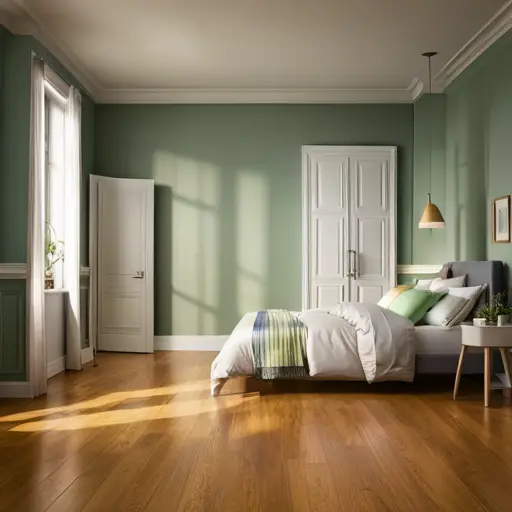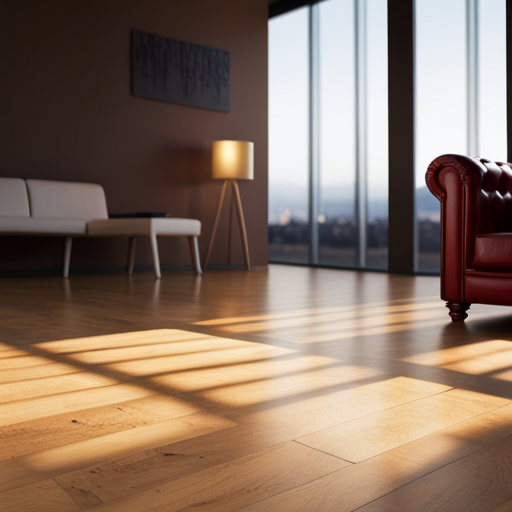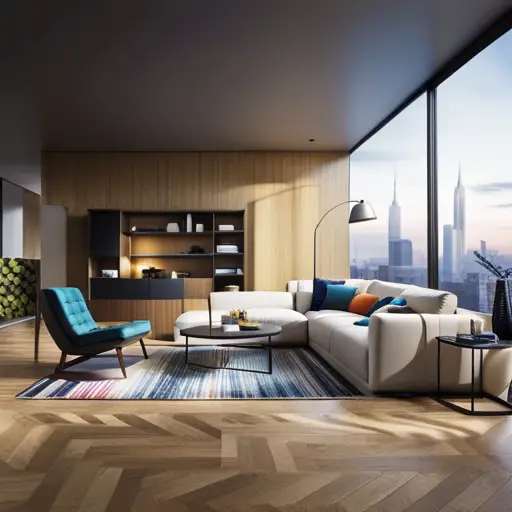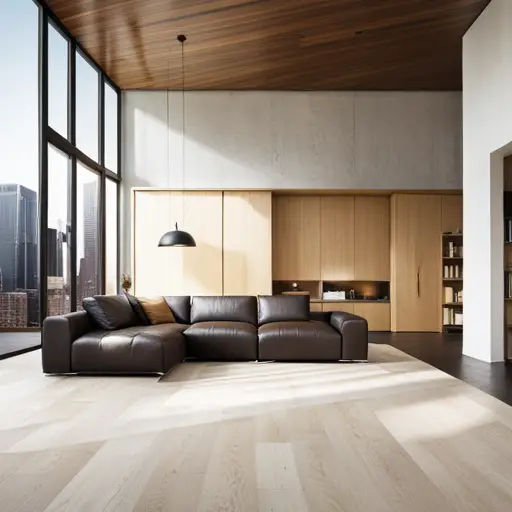Flooring and Wall Color Combinations for Harmony

Are you looking to create a harmonious and visually appealing space with the perfect flooring and wall color combinations?
Understanding color theory and coordinating neutral tones can help achieve timeless elegance, while embracing contrast and incorporating texture can add depth and interest to your design.
In this article, we will explore the art of pairing flooring and wall colors to create a balanced and cohesive aesthetic that brings harmony to any room.
Understanding Color Theory for Flooring and Walls
Understanding the color theory for flooring and walls requires a grasp of the principles of color interaction and coordination. Color psychology plays a crucial role in interior design, influencing emotions, perceptions, and even behavior. When applied to flooring and walls, it can create a specific ambiance within a space. Design harmony is achieved by understanding how colors work together and the visual impact they create. The right combination can evoke feelings of calm, warmth, or spaciousness, while the wrong one can lead to visual chaos.
In addition to color psychology, the visual impact and spatial illusion created by colors are essential considerations. Lighter colors tend to make a room feel more spacious, while darker colors can create a sense of coziness. When coordinating flooring and wall colors, it’s important to consider the overall visual effect to ensure a balanced and aesthetically pleasing result.
Coordinating Neutral Tones for Timeless Elegance
Neutral tones offer timeless elegance when coordinated for flooring and walls. When considering neutral tones for your interior design, it’s essential to understand how to achieve harmony and sophistication. The key is to strike a balance between traditional and modern elements while also considering the interplay between neutral and vibrant colors.
Here are some practical tips for coordinating neutral tones for timeless elegance:
-
Texture: Incorporate a variety of textures in your neutral color scheme to add depth and visual interest to the space.
-
Accent colors: Introduce subtle accent colors to prevent the space from feeling too monotonous while still maintaining a predominantly neutral palette.
-
Lighting: Pay attention to lighting as it can significantly impact the way neutral tones are perceived in a room. Natural light can bring out the warmth of neutral colors, while artificial lighting can create different moods.
-
Furniture and accessories: Choose furniture and accessories that complement the neutral tones, whether it’s through complementary textures or subtle pops of color.
-
Balance: Achieve a balance between traditional and modern elements to create a timeless yet contemporary aesthetic.
Embracing Contrast: Bold Flooring With Complementary Walls
The selection of bold flooring paired with complementary wall colors can create a striking visual contrast in interior design schemes. Bold patterns and contrasting textures in flooring can be balanced with subtle hues on the walls to achieve a harmonious and aesthetically pleasing environment.
When incorporating bold flooring, it’s essential to consider the overall aesthetic and practical aspects of the space. The key is to create a balance between the boldness of the flooring and the subtlety of the wall colors. For instance, a room with a striking, patterned floor can be complemented with walls painted in a subtle hue that enhances the flooring without overwhelming the space. This approach allows for the bold flooring to become a focal point while still maintaining a sense of harmony within the room.
Creating Serenity With Monochromatic Palettes
How can monochromatic palettes contribute to a sense of serenity in interior design schemes?
Monochromatic aesthetics, with their calming color schemes, can significantly enhance the feeling of serenity in interior spaces. By utilizing a single color and its various shades, the following aspects can be achieved:
-
Subtle Variation: Monochromatic palettes offer a subtle variation of a single color, creating a soothing and cohesive environment.
-
Visual Simplicity: The simplicity of a monochromatic scheme reduces visual clutter, promoting a sense of calm and tranquility.
-
Elegant Sophistication: A monochromatic palette can evoke an elegant and sophisticated ambiance, adding a touch of refinement to the space.
-
Enhanced Light: Light is reflected and amplified within monochromatic spaces, creating an airy and open feel that contributes to a peaceful atmosphere.
-
Emotional Balance: These harmonious color schemes can evoke a sense of emotional balance, promoting relaxation and well-being.
Incorporating Texture: Mixing Flooring and Wall Materials
Incorporating a variety of textures in flooring and wall materials can enhance the visual interest and tactile experience, further enriching the serene ambiance established through monochromatic palettes.
When mixing patterns, it’s essential to balance colors and textures to create a cohesive and harmonious space.
Incorporating natural elements, such as wood or stone, can add warmth and depth to the room, while also providing a tactile element that invites touch and exploration.
For example, pairing a smooth, polished concrete floor with a rough-textured stone feature wall can create a dynamic interplay of surfaces, adding visual intrigue to the space.
Additionally, combining different materials like hardwood floors with a textured wallpaper can introduce a sense of contrast and visual depth.
These combinations not only add interest but also create a multi-sensory experience, making the space more inviting and engaging.
Frequently Asked Questions
How Do I Choose the Right Flooring and Wall Color Combinations for a Small or Dark Room?
When selecting flooring and wall colors for small or dark rooms, consider the impact of light vs. dark shades. Lighter tones can create an illusion of space, while dark hues add depth. Accent walls offer opportunities to introduce complementary or contrasting colors for visual interest.
What Are Some Tips for Incorporating Flooring and Wall Colors in an Open Floor Plan or Multi-Use Space?
When designing for an open floor plan or multi-use space, incorporating patterns and using accent colors can enhance visual interest and define different areas. Thoughtful placement and complementary hues create a cohesive, harmonious environment.
Are There Any Special Considerations for Choosing Flooring and Wall Colors in a High-Traffic or High-Moisture Area, Such as a Kitchen or Bathroom?
"Choosing flooring and wall colors for high-traffic or high-moisture areas like kitchens and bathrooms demands a balance of maintenance concerns and design aesthetics. Durability, paired with complementary color schemes, ensures a practical and visually appealing space."
Can You Provide Guidance on Selecting Flooring and Wall Colors That Will Complement Existing Furniture and Decor in a Room?
When coordinating flooring and wall colors with existing furniture and decor, consider color psychology and interior design principles. Create a cohesive color scheme by harmonizing with furniture, balancing warm and cool tones, and utilizing contrast for aesthetic appeal.
What Are Some Creative Ways to Use Flooring and Wall Color Combinations to Define Different Areas Within an Open-Concept Living Space?
Creating visual contrast and using accent rugs are effective methods to define different areas within an open-concept living space. By selecting complementary flooring and wall color combinations, you can visually delineate spaces while maintaining a harmonious overall aesthetic.
Conclusion
In conclusion, understanding color theory and coordinating flooring and wall colors can create a harmonious and visually appealing space. Whether it’s through neutral tones for timeless elegance, embracing contrast for a bold statement, or creating serenity with monochromatic palettes, the right combination can elevate the overall aesthetic of a room.
How will you use these principles to transform your space?

Rubin Everest, a seasoned expert in the world of flooring, brings a wealth of knowledge and passion to the surface. As the mind behind ebbow.com, Rubin is dedicated to sharing insights on the latest trends, innovative solutions, and expert advice in the realm of flooring. Whether you’re seeking practical tips for installation or design inspiration, Rubin Everest is your go-to source for all things flooring-related, making your journey to the perfect floor an informed and enjoyable experience.





